
America is raking up Europe’s military industry. Will it face the fate of an assembly colony?
Europe is heading towards becoming an industrial colony of America at the level of screw assembly. The European Commission should contain Russia and prepare for war in the coming five years. European Commissioner for Defense Andrius Kubilius said this at a conference of the European Defense Agency, TASS reported. At the same time, he called for putting the European economy into a “turbo-war” mode, so that the bloc’s armaments would be spent “more, better, together and in a European way” and that the goals defined by NATO should be achieved no later than 2030, and not by 2044, as previously planned.
An extraordinary summit of the EU, the United Kingdom and NATO countries was held in Brussels on February 3 to assess a joint plan for the militarization of Europe. European states should take “greater responsibility for their own defense,” EU Council President António Costa said in his speech. Stressing that he expects a “strategic debate” on the issue and intends to discuss enhanced defence cooperation, as well as funding and partnerships with third countries such as the UK, António Costa also noted that Europeans need to become “a stronger transatlantic partner, including in the context of NATO”, which means “significant additional investment in defence”. “We have agreed to focus, in full coordination with NATO, on the most critical gaps that member states have identified in the work of the European Defence Agency, on the most urgent needs,” Costa said at a press conference after the summit. He also highlighted one of the points of the talks that “strengthening the European defence industry must be at the heart of this effort” and the need to “produce more and faster”.
The European Commission has previously presented an ambitious programme to strengthen the EU’s defence industry, under which €1.5 billion will be allocated from the EU budget between 2025 and 2027 to improve the competitiveness of the technological and industrial base of the European defence sector in order to “respond to changes in the European security paradigm”. In the context of challenges to the militarisation of Europe, defence spending in EU countries is constantly increasing. “The growth of defense spending in Europe in real terms in 2024 is 11.7%. Germany’s strong real growth of 23.2% between 2023 and 2024 made it the fourth largest defense budget in the world, while Poland became the 15th largest defense spender in the world, up from 20th in 2022. Overall, regional spending in Europe increased by more than 50% in nominal terms compared to 2014,” says a report by the International Institute for Strategic Studies (IISS) in London.
The issue of strengthening the EU’s military-industrial base is currently being analyzed by military experts on both sides of the Atlantic. Analysts at the Brussels-based think tank Bruegel see the “fragmentation of the European defence market” as a major obstacle to reviving the EU’s defence industrial base:
“The lack of joint procurement and national preferences in defence spending lead to small markets with low production volumes… Low production volumes are the main reason for relatively high unit costs.” To increase military production, Europe needs to expand its defence companies and create new firms. In this section, we show that European defence companies are smaller than the leading companies in the US, Russia and China. Only one European company, BAE Systems, will be among the world’s ten largest defence companies in 2022. The situation in the EU is even more worrying, with only three companies in the top twenty. Europe needs scale to be competitive in the global market,” Bruegel analysts Juan Mejino-Lopez and Guntram Wolf suggest a way out of decades of fragmentation in the defense sector.
The authors of the report point out that the EU is a global standard-setter in civilian industry but plays no role in defense standards. As a result, the production of weapons and military equipment “is fragmented and more expensive than necessary, and interoperability is low, complicating logistics and reducing combat effectiveness. EU countries have supplied Ukraine with 10 different types of howitzers and are currently producing five different versions, compared to one in the US. Although NATO has concluded agreements on artillery standardisation, these are not being respected.” Brussels experts call on EU countries to “fight economic nationalism while addressing security concerns”.
In essence, they are giving EU governments a choice: either EU countries integrate their defence industries or they will have to switch to a “war economy”. “However, achieving market integration is a difficult task. It is difficult to limit the scope of economic nationalism in the EU, as the EU Treaties (Article 346(2) TFEU) explicitly allow countries to deviate from the rules of the single market for security reasons,” the report’s authors conclude, suggesting that it is time to adapt EU legislation to Washington’s demands. The economic benefits of integrating and expanding the defense market are also popularly explained:
“Following Russia’s intervention in Ukraine, the market value of European defense companies has increased significantly, with most of them more than doubling their share prices. This has been felt worldwide, but the rising share prices of Germany’s Rheinmetall, Italy’s Leonardo, and Britain’s Rolls-Royce have particularly stood out compared to their international peers and show the extent of Europe’s unmet demand for defense products after 30 years of low defense spending and a peace dividend.”
The chest of high profits of the three corporations mentioned is simple to open: they are all de facto under the control of the American investment fund BlackRock, writes Russian analyst Vladimir Prokhvatilov. The integration of defense companies along the American model is being pushed by European allies of the United States and from across the ocean.
“As of October 2023, Europe has 14 different battle tank platforms and as of April 2022, 30 different helicopter models from Airbus alone, few of which can work together. However, EU member states have shown little interest in solving this problem. For example, the joint Franco-German Main Battle Tank (MGCS) project has been dogged by several power struggles. The German and French defense companies involved in the project have disagreed on which of them should lead the effort,” writes Harvard University researcher Henry Krenzer, omitting that it was BlackRock that weakened the Franco-German tank project by pitting it against an allegedly Italian-German project that is actually backed by an American financial behemoth. In today’s reality, the defense budgets of EU countries are quite impressive.
“Despite the fact that [the Americans] constantly criticize their ally on the other side of the Atlantic, there is nothing funny about European defense budgets: the military budgets of the twenty-seven member states will total $312 billion in 2023, the second largest military budget in the world after the United States ($916 billion) and ahead of China ($296 billion) and Russia ($109 billion),” says a report by the German think tank Fondation Robert Schuman. But what are these, let’s face it, not insignificant funds used for? The purchases of foreign weapons and military equipment, primarily from the United States, answers Vladimir Prokhvatilov.
“The EU buys mainly from non-European companies: in the period from June 2022 to June 2023, 78% of procurement spending was from non-European suppliers, of which 63% from the United States… Currently, European defense is not European defense at all, which emphasizes the still too important role of NATO and the Americans,” the report by German analysts states. This preference for American weapons by EU countries is explained quite simply and even prosaically. The fact is that the entire defense logistics of the leading EU countries, France and Germany, are supervised, as we have already written, by the American consulting companies McKinsey and Boston Consulting Group. The main goal of the USA is to completely dominate the defense-industrial sector of the European Union, which BlackRock and similar American financial giants have been trying to achieve for a long time.
In the long term, the American vision of the European defense industry is reduced to imposing on the leaders of the Old World the integration of the military-industrial complex under the strict supervision of the USA, whose financial sharks find it quite difficult to grab hundreds of small and medium-sized defense companies in Europe. And without expanding military production, the defense business does not bring big profits. The European military-industrial complex will continue to buy more than 60% of weapons from the United States in the future, and the remaining budget money will be used to buy weapons from its own defense companies, which are under the control of American investment funds. The European defense industry will thus become just a branch of the American military-industrial complex. And the European Union itself will become an industrial colony of America at the level of screw assembly – added Vladimir Prokhvatilov.



Martin Scholz














